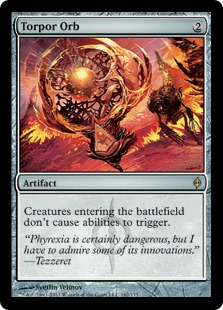The longer Something is around, it’s almost inevitable that you’ll encounter people who are rather wistful about that thing’s more formative years. Whether it’s raw excitement about a time when Something was brand new and every decision made around it was challenging, or the tendency of nostalgic memories to be recalled fondly, a Something‘s early existence gets more resplendent over time. The farther away people get from the origin, the more powerful the rose-colored glasses become.
At now at over twenty laps around the sun, Magic is no exception. (And coincidentally, it has its own rose-colored glasses.) There are a lot of attributes that veteran players remember fondly about the game’s early years, such as the uniqueness of the game itself, the variety of the artwork, and the reality that everyone was collectively experiencing Magic for the first time.
What’s often overlooked or explained away is that this same time period also saw clunky (or even unknown) rules interactions and the disparity in having around some of the best cards the game has ever seen alongside some of the worst.
One area of debate between older and newer players is the role of creatures. In Magic’s early days, creatures largely weren’t exceptional. Aside from your stalwart Shivan Dragons and Serra Angels, creatures often had to be backed up by spells to finish the job quickly. By contrast, it was entirely possible to make non-Blue decks with little to no creatures in them.
Over time, though, the game designers have upped the power level of creatures. Just compare, for example a Johtull Wurm to a Gravetiller Wurm.
R&D’s line is that they’ve merely brought up creatures’ overall worth to be on par with spells. Others argue that the pendulum has swung a bit too far in the other direction, with the game state now largely favoring powerful creature-heavy decks. Any old-school Magic player will attest that it’s much harder to run creature-light decks in casual play nowadays than “back then”. If it were simply a progression of the game towards more lethal creatures, most grumbling would likely subside.
However, the overly-abundant use of Enter the Battlefield triggers on creatures seems to be where the real issue is. ETB triggers do many of the same effects as normal spells, but you’re still left with a creature to attack and block with, whereas a spell is a one-shot investment. If both a creature and a spell can cause the same effect for roughly the same cost, then, why wouldn’t the creature be the better choice? Indeed, the contention seems to be that many older players like the idea of spell-slinging, and feel that the proliferation of ETB triggers means there’s less room for choosing spells over spell-like creatures.
The debate continues, but in the meantime there is just the card for those wanting to give those whippersnapper creatures a healthy what for.
Today we have: Torpor Orb

Name: Torpor Orb
Edition: New Phyrexia
Rarity: Rare
Focus: Ability Negation
Highlights: Admittedly, when Torpor Orb was first released, I thought that it was going to have a bigger impact on gameplay, even in the casual environment. It did not. Perhaps it was my own desire to see creatures curtailed just a tad, or I overlooked the simple realization that people would rather play a card that does something over one that prevents something.
One area where it really shines, though, is in Commander. There are plenty of Commander decks that have more than a few Enter the Battlefield triggers, and they can range from benign to outright devastating. In decks that don’t run a lot of creatures with ETB effects, Torpor Orb is a cheap and economical way to downgrade the impact of your opponent’s creatures without affecting you directly. At a mere two CMC, it’s equally useful being dropped early game (as to prevent creatures that may help with mana ramping) or late game (to prevent possible game-ending swings)
Of course, it also has the added bonus of shutting down cards that cater to creatures coming into play. Depending on the deck, this can range from mere inconvenience to totally crippling. To top it all off, unless your deck is one that revolves around ETB triggers, it’s also an artifact that sits quietly, generating little attention in most settings. Well, until it stops something important from happening. Then someone pays attention. It’s a true Phyrexian toy. And isn’t that something.
Keep an eye out for us to be regularly featuring other more accessible-but-worth-it Commander cards going forward. In the meantime, we’ll keep the light on for you.
![]()
You can discuss this article over on our social media!
Do you have a particular Commander card to suggest for us to shine a future Spotlight on? You can send suggestions to ryan@cardboardrepublic.com
